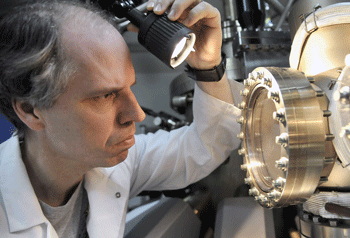- News
24 January 2012
Naval Research Laboratory’s Brian Bennett made Fellow of American Physical Society
Dr Brian Bennett, a scientist at the US Naval Research Laboratory (NRL), has been named a Fellow of the American Physical Society (APS) in recognition of his “pioneering contributions to the epitaxial growth, characterization, and design of narrow-bandgap semiconductor heterostructures”.
 Bennett has made key contributions in materials physics over the last two decades. Earlier work included highly cited contributions on electro-optical effects in silicon and III-V compounds as well as self-assembled quantum dots. His primary focus over the last several years has been in the design, growth and characterization of antimonide-based heterostructures for application to high-frequency, low-power electronics.
Bennett has made key contributions in materials physics over the last two decades. Earlier work included highly cited contributions on electro-optical effects in silicon and III-V compounds as well as self-assembled quantum dots. His primary focus over the last several years has been in the design, growth and characterization of antimonide-based heterostructures for application to high-frequency, low-power electronics.
Picture: Brian Bennett transfers samples into a molecular beam epitaxy system prior to the growth of InAs quantum wells for high-speed transistors with ultra-low power consumption. (Photo: Jamie Hartman, US Naval Research Laboratory.)
The Naval Research Laboratory claims that Bennett’s research (in collaboration with J. Brad Boos and colleagues) has established it as the world leader in this field. His efforts on the design and epitaxial growth of high-electron mobility transistors based on indium arsenide (InAs) quantum wells and antimonide barriers helped to develop a technology that was transferred to industry, leading to the production of low-noise amplifiers operating at ultra-low power for US Department of Defense (DoD) applications.
Bennett received his bachelor’s degree (1984), master’s degree (1985) and doctorate (1992) all from the Massachusetts Institute of Technology. He served as a military officer in the US Air Force’s Solid-State Sciences Division from 1984 to 1988. He has been at NRL since 1992 and currently serves in the Electronics Science and Technology Division as head of the Nanotechnology Section, which includes 12 PhD scientists working on topics including graphene, carbon nanotubes, quantum wires, atomic layer deposition (ALD), and plasmonics. Results of his research have been reported in over 160 archival journal publications and cited over 5000 times. He also holds ten US patents, and has served as an organizer and/or committee member of Electronic Materials Conference since 2000.
Bennett has previously been recognized with an NRL Technology Transfer Award in 2001; an NRL Group Achievement Award in 2004 for transition of Sb-based HEMT technology developed at NRL to Northrop-Grumman Space Technology; an NRL Edison Patent Award in 1998 and 2009; an NRL Berman Publication Award in 1998, 2000, and 2008; and a Navy Top Scientist/Engineer of the Year Award (one of 18 out of 35,000 eligible) in 2009.
